|
A walk among lakes and woods in the company of a precious guide,
symbol of the safeguarding of places, told by an affectionate connoisseur
of Nature in this area.
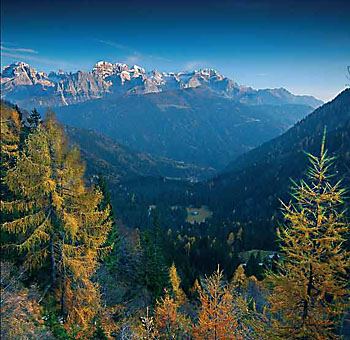

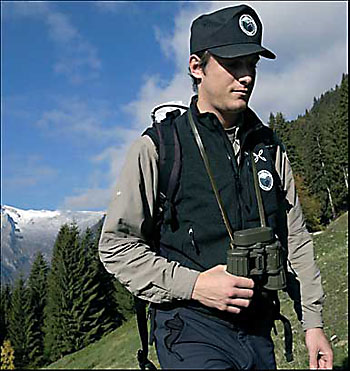

Park-guards working in Adamello Brenta
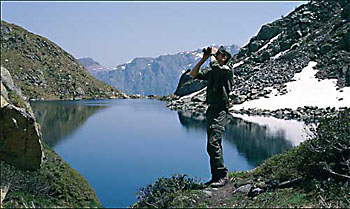
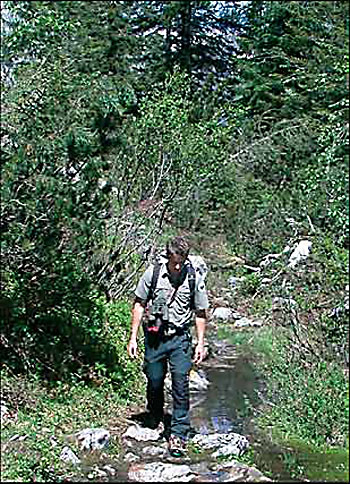
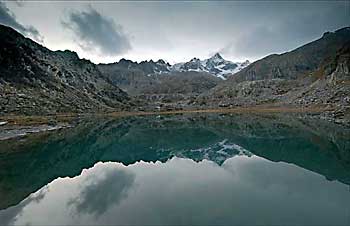
Lago di Cornisello
(foto Daniele Pellegrino)
|
|
AT THE LAKES OF CORNISELLO
WE OWE PARK GUARDS
A LOT
by Manuela Stefani
The sun is shining over Val Rendena making everything
glow of a beautiful brilliance. Quiet and massive, the two natural
bulwarks, Presanella-Adamello and the Brenta
Dolomites, towering from above, are dressing up with lights and
a fairy-tale charm as gigantic castles made of stone. The deep
green of the forests lights up with golden reflections and it
illuminates the mirrors over a thousand lakes, tinged with every
shade of blue.
The more and less known valleys still continue echoeing of rumbling
water, which roars and gurgles alternatively: the wild Nambrone
valley, the isolated Val di Borzago, the
well-known Val di Genova, the solitary Val di Fumo, while bunches
of locals and tourists keep pouring into the villages’ streets
and alleys. Nothing in the world would make them renounce to the
extraordinary show of a blue sky over their heads and the pleasant
warmth of the sun
that heats up their skin and bones.
Bulwark of winter and summer tourism, thanks to its “capitals”,
Madonna di Campiglio and Pinzolo, and to the less mundane, but
surely more suggestive villages, crowed
both in summertime and wintertime, loved by skiers and escursionists,
attended equally by Italians and foreigners, Val Rendenais, as
a matter of fact, a place which nature has given a lot.
A beauty that needs to be safeguarded.
In order to safeguard an heritage of such value, Val Rendena has
become part of what is the biggest natural park in Trentino, i.e.
Parco Adamello-Brenta. 620 square kilometres protected and supervised
by a small army of nature-friends: the park guards. Just a few
more than ten people: not many, if you consider the vastity of
the area, the human presence, both residential and touristic,
over which they have to watch.
Michele Zeni, age 26, is one among the yougest guards.
He chose his job already when he was 13, because that was exactly
what his father was doing. From that age, as a matter of fact,
his father had been teaching him to love
mountains and the place he was growing up in.
He is taking us out on the excursion.
Direction: lakes of Cornisello, two small communicating basins,
at the top of Val Nambrone. We are lucky having him with us: Michele
is a pleasant mate and a true mine of
information.
“The vegetation is abundant and varied: willows, birches,
sorbs, laburnums, elders, and larches, which have always represented
the richness of these valleys. Up high, there are the fir trees.
Here they take the typical column shape: the long winters, the
bitter cold and the overload of snow makes the longest branches
break. To this process, nature has found a solution”. Summer
rhododendron cushions
colour the slopes which are cluttered, in Val Nambrone, of stonemade
panettoni, usually smooth and rounded: “they are called
montonate rocks” – says Michele.
“The glaciers have eroded and smoothed them down completely.
During the autumn, when you can spot around here the capercaillie,
the rarer black grouse and the mountain hazel hen, when the days
are clear from dawn to dusk, the mountains are quiet and the animals
come out surely more often.
The real eagles fly in the sky. The deers change the colour of
their mantle, which is reddish during the summer, and fades to
brownish in the autumn, getting also longer.
The Alpine chamoises do the same: they become darker when the
cold comes.”
Bunches of volunteers and workers are looking after mountain paths
and pastures. They take away the thistles from the fields while
the paths are always kept clean: “the
slopes tend to be quite instable and dangerous. For this reason,
we move rocks, we force back the trees from an exuberant growing,
and we protect landslide risk areas
witht the help of special nets”, our guide informs us.
The water is abundant in Val Nambrone, a totally different situation
than in the more arid Val Brenta, “it is thanks to the impermeability
of the rocks that we have a lot of superficial water: the glaciers
– as a matter of fact – when melting, form lakes and
streams that cannot filter into the underground as it happens
instead in the Dolomites”, says
again Michele. You walk nicely in Val Nambrone: the hiking is
not difficult at all, the spectacular places fill your eyes and
soul and the company of a parkguard enriches the mind. So, pleasantly,
we get to the lakes of Cornisello. The water is icy and opaque
on account of the glaciers
nearby and as the result of the carrying of sedimentary material
downhill.
“Here lives the alpine char, an endemism which has adapted
itself to live in this climate, extremely prohibitive
for most kind of fish, – explains young Zeni. – Unfortunately,
a few years back, before the supervision
of the Park, there have been introduced in these very waters the
iridea trouts, coming from North America, very much appreciated
by sporting fishers. Unfortunately, they have created problems
to the more fragile chars and some kind of imbalance to the ecosystem”.
The way back flows more rapidly than the way out: as we descend,
we make the effort of fixing, in our mind and in our eyes, the
fragments of the miracle of perfection represented by nature in
this peculiar corner of the world, not that far away from our
home. Will it remain untouched
like it is today for future generations? To guarantee its preservation
as it is, young Zeni and others like him are doing their best.
We feel we owe them a lot.
Manuela Stefani, is senior editor
of the monthly magazine Airone, journalist and writer, and has
recently published for Mondadori the novel La casa degli ulivi.
|







